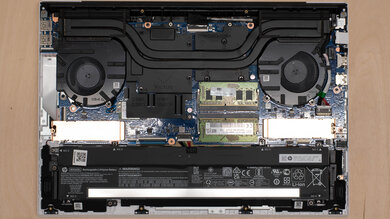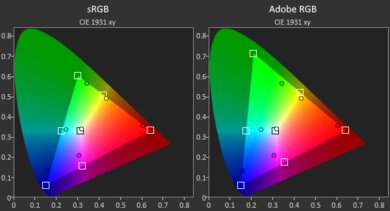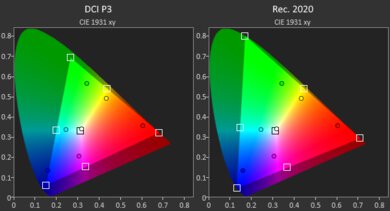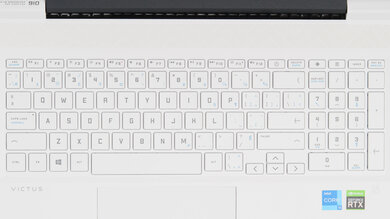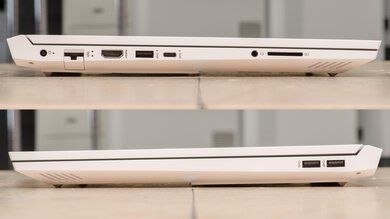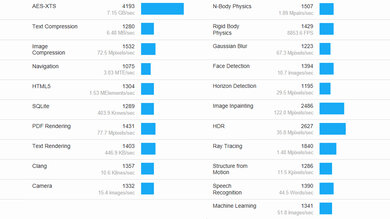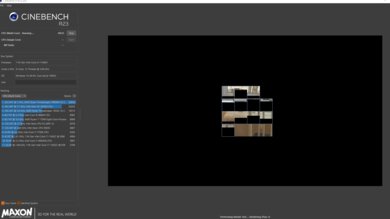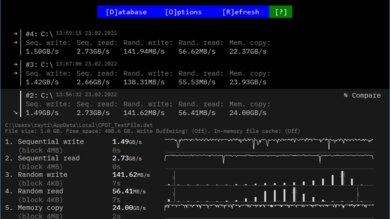The HP Victus 16 (2021) is a 16-inch budget gaming laptop. It's available with Intel 11th Gen. CPUs and various NVIDIA discrete GPUs, ranging from an entry-level NVIDIA GeForce GTX 1650 to an NVIDIA GeForce RTX 3060. It also has multiple display options, from an FHD (1920 x 1080) 60Hz to a QHD (2560 x 1440) 165Hz panel. You can get up to 32GB of memory and over 1TB of storage in a RAID 0 array or in combination with Intel Optane memory. Its port selection includes three USB-As, one USB-C, an SD card reader, an Ethernet, and an HDMI 2.1 port. It has a full-size keyboard with a Numpad, a 720p webcam, and Wi-Fi 6.
See our model's specifications and the available configuration options in the Differences Between Variants section.
Our Verdict
The HP Victus is okay for school use. It's a fairly bulky laptop that's a little cumbersome to carry around, and you'll likely have to bring the charger with you as the battery lasts less than six hours of light productivity. However, it provides a good user experience with its large screen, comfortable keyboard, and responsive touchpad. Its Intel 11th Gen CPU and NVIDIA dedicated GPU can handle fairly demanding workloads, making it suitable for students in graphic design or 3D animation. It has a wide port selection that includes multiple USB ports and an HDMI, so you can easily connect peripherals and external monitors.
- Comfortable keyboard and responsive touchpad.
- CPU and GPU can handle heavy workloads.
- Good webcam video quality for video calls.
- Bulky and heavy.
- Battery lasts less than six hours of light productivity.
- Screen doesn't get bright enough to combat glare.
The HP Victus 16 is great for gaming. Its Intel Core i5-11400H and NVIDIA GeForce RTX 3050 provide relatively smooth gameplay in graphically demanding AAA titles at 1080p with medium or low settings. You can also configure the laptop with a more powerful Core i7 or RTX 3060, which will get you even higher frame rates. Only the CPU throttles a bit under load, so performance remains consistent even if you play for an extended period. There are multiple display options, including a 165Hz QHD panel; however, none of them support variable refresh rate to reduce screen tearing.
- CPU and GPU provide a smooth gaming experience.
- Minimal throttling under load.
- Doesn't get overly hot or loud under load.
- 144Hz display with good response time.
- No VRR support to reduce screen tearing.
- Ray-tracing isn't worth enabling due to high performance cost.
The HP Victus laptop is mediocre for media consumption. It's a bulky and heavy laptop that's hard to carry around, and its battery lasts less than five hours, which is only enough to get you through two full-length movies at the most. Its speakers sound good but don't get very loud, and while the display is reasonably sharp, colors look washed out and inaccurate. Also, it doesn't get bright enough to combat glare, and its low contrast makes blacks look gray in dim settings. That said, you can get the laptop with a brighter and more colorful 1440p panel, which will provide significantly better image quality.
- Speakers sound well-balanced with good vocal presence.
- Screen gets very dim for a more comfortable dark room viewing experience.
- Flicker-free backlight helps reduce eye strain.
- Washed out colors.
- Blacks look gray in dim settings.
- Screen doesn't get bright enough to combat glare.
- Battery lasts less than five hours of video playback.
The HP Victus is excellent as a workstation. It's available with Intel 11th Gen CPUs and NVIDIA 30-series discrete GPUs, which can handle fairly heavy workloads like video editing and 3D animation, especially the top-end Core i7 and RTX 3060. You can get up to 32GB of memory and 1TB of storage, and both are user-replaceable, so you can upgrade later if needed. You might need an external monitor for color-correction work, as even the top-end QHD display only has full sRGB coverage. Thermal throttling is minimal, and while the fans get loud, they aren't overly annoying. Its port selection includes multiple USB and an HDMI 2.1 port, but its USB-C doesn't support Thunderbolt or USB4.
- CPU and GPU can handle heavy workloads.
- Minimal throttling under load.
- Doesn't get overly hot or loud under load.
- Wide port selection includes HDMI 2.1 port.
- USB-C doesn't support Thunderbolt.
The HP Victus is good for business use. It feels well-built even though it's entirely plastic, and it has a sleek design that doesn't stick out in a professional office environment. However, it isn't very portable because it's bulky and heavy, and its battery lasts less than six hours of light productivity, so you'll have to carry the charger with you. The keyboard feels great to type on, the touchpad is large and responsive, and the webcam captures a good image for video calls. Its Intel 11th Gen CPU can handle productivity tasks like text formatting, web browsing, presentations, and even heavy number crunching in spreadsheets.
- Comfortable keyboard and responsive touchpad.
- CPU and GPU can handle heavy workloads.
- Wide port selection includes HDMI 2.1 port.
- Good webcam video quality for video calls.
- Bulky and heavy.
- Battery lasts less than six hours of light productivity.
- Screen doesn't get bright enough to combat glare.
Changelog
-
Updated Nov 20, 2024:
Added mention of the HP Victus 16 (2024) as an alternative with NVIDIA's 40-series GPUs in the GPU section.
- Updated Mar 01, 2024: We've updated the review for clarity and readability.
- Updated Dec 07, 2023: Converted to Test Bench 0.8.2.
- Updated Nov 03, 2023: Converted to Test Bench 0.8.1.
Differences Between Sizes And Variants
We tested the HP Victus 16 (model 16-d0018ca) with an Intel Core i5-11400H CPU, an NVIDIA GeForce RTX 3050 dedicated GPU, 16GB of memory, and 512GB of storage. The screen, CPU, GPU, memory, and storage are configurable; you can see the available options in the table below. This review applies only to laptops in the 16t-d000 and 16-d0000 series.
| Screen |
|
|---|---|
| CPU |
|
| GPU |
|
| Memory |
|
| Storage |
|
| Color |
|
See our unit's label here.
Popular Laptop Comparisons
Compared to other gaming laptops in its class, the HP Victus gaming laptop stands out for its sturdy build and the quality of its keyboard and touchpad. It has a sleeker design with fewer gamer aesthetics than other gaming laptops, so it doesn't stick out in a classroom or office.
For more options, check out our recommendations for the best gaming laptops, the best laptops, and the best Windows laptops.
The HP Victus 16 (2021) and the Lenovo LOQ 15 (2023) are both budget gaming laptops. The HP is better regarding the user experience, meaning it has a sturdier build, a better keyboard, and a more responsive touchpad. The Lenovo will provide smoother gameplay since it's a newer device with more powerful CPUs and GPUs. If you can afford to stretch your budget, it's worth getting the Lenovo, as its NVIDIA 40-series GPUs support frame generation, a feature that can dramatically boost performance by inserting A.I.-generated frames.
The ASUS TUF Dash F15 (2022) and the HP Victus 16 (2021) are very similar, although the ASUS is slightly better. It's more portable than the HP because it's a smaller laptop, and it feels more sturdily built. Also, it's available with faster Intel 12th Gen. CPUs and a higher-end NVIDIA GeForce RTX 3070 GPU.
The Lenovo IdeaPad Gaming 3i (2021) and the Acer Nitro 5 15 (2020) are very similar budget gaming laptops. The Lenovo comes out ahead in terms of user experience because it has a better keyboard and touchpad, and it's available with more powerful GPU options that can provide higher frame rates in games. The Acer's keyboard isn't uncomfortable; it just doesn't register some keystrokes at times, which might be a dealbreaker for some. The Acer has much longer battery life, lasting over four hours longer than the Lenovo in light productivity workloads, albeit only slightly longer when gaming.
The Dell G15 (2022) and the HP Victus 16 (2021) are very similar budget gaming laptops. The HP provides a better user experience with a sturdier build, a more comfortable keyboard, and a more responsive touchpad. However, the Dell has higher-end display and GPU configuration options, like a 1440p 240Hz display and an NVIDIA GeForce RTX 3070 Ti GPU. The Dell's Intel 12th Gen. CPUs also perform better than the HP's AMD Ryzen 5000-series processors, providing better frame rates in games and a smoother experience in demanding tasks like video editing.
Test Results

The HP Victus 16 has a clean and minimalist design. It has a touch of gamer aesthetic, like the V shapes in the speaker grills above the keyboard, but it's subtle and doesn't stick out in a professional working environment. The bezels are relatively thin on three sides; however, the bottom chin is much thicker, with a silver-colored Victus logo at the center. It's available in three color schemes: Ceramic White, Mica Silver, and Performance Blue.
The build quality is good. The laptop feels sturdy even though it's entirely plastic, and there aren't any gaps in the construction. The display and keyboard deck flex a bit, but not enough to be of concern. The white model doesn't pick up many fingerprints, but the Mica Silver and Performance Blue models likely do. The feet feel solid and stick firmly to the bottom.
The serviceability is excellent. It's very easy to access the internals, as you only need to remove some Philips screws before prying open the bottom panel. The M.2 2280 storage slots support PCIe 3.0 or PCIe 4.0 NVMe SSDs. See the service manual here.
The HP Victus gaming laptop has five display options. All five are IPS panels but with different refresh rates, advertised brightness, and color gamut coverage, as you can see below:
- 1080p 60Hz (45% NTSC, 250 cd/m²)
- 1080p 60Hz (100% sRGB, 300 cd/m²)
- 1080p 144Hz (45% NTSC, 250 cd/m²)
- 1080p 144Hz (100% sRGB, 300 cd/m²)
- 1440p 165Hz (100% sRGB, 300 cd/m²)
The 1080p panels are reasonably sharp at this screen size. The 1440p display is sharper and will provide a more immersive experience in atmospheric games; however, none of the available GPUs are powerful enough to deliver a smooth experience at this resolution. The NVIDIA GeForce RTX 3060 can handle some light games at 1440p but not graphically demanding AAA titles. The 1440p panel is still a viable option if you plan on using the laptop for work or school, as it gives you more screen real estate for multitasking. The 16:9 aspect ratio is fairly typical for a gaming laptop. However, it doesn't provide as much vertical space as productivity-focused laptops with a 16:10 or 3:2 aspect ratio, so you have to scroll more often when reading a document or website.
The HP Victus' motion performance depends on which panel you get. The 144Hz and 165Hz displays provide a smoother and more responsive gaming experience than the 60Hz panels. The 144Hz panel has a decent response time, resulting in only a short blur trail behind fast-moving objects, and the 165Hz panel performs similarly. However, the 60Hz panels perform worse, producing a blurrier image with more noticeable ghosting. Unfortunately, none of the panels support variable refresh rate to reduce screen tearing. If you want a laptop with a higher refresh display, check out the Lenovo Legion Pro 5 Gen 8 16 (2023).
The 144Hz FHD's contrast ratio is good and within the typical range of most IPS panels. However, it's a relatively low number compared to other panel technologies like VA and OLED. This level of contrast makes blacks look gray in dim settings. The other panels likely have the same contrast.
The 144Hz FHD display doesn't get very bright, so it's best to avoid using it in a well-lit or sunny environment. It gets very dim at the lowest brightness setting, which is great for dark room viewing as it's easier on the eyes. As specified in the screen section, there are panels with an advertised 300 cd/m² brightness, but that still isn't enough to make it suitable for use in very bright rooms or outdoors in broad daylight.
The display's reflection handling is good. Its matte anti-reflective coating works well against lights shining directly at the screen. However, bright ambient lighting makes the screen look hazy, which is very distracting when viewing dark scenes.
The display's horizontal viewing angle is okay. The image dims and washes out quickly as you move off-center. The image quality is still good enough to share text documents and such with someone else, but you have to look at the screen relatively straight on if you want to see an accurate image.
The display's vertical viewing angle is mediocre. The image quality degrades fairly quickly, which can be an issue if you're using the laptop in a position that forces you to look at the screen from above or below. It isn't too bad for gaming or light productivity tasks like text formatting and web browsing, but it isn't ideal for color-critical work.
The display's out-of-the-box accuracy is bad. Most colors are inaccurate due to the panel's narrow color gamut, and the white balance is off. The color temperature is slightly warmer than the standard 6500K target, resulting in a barely noticeable reddish tint. The gamma doesn't follow the sRGB curve and sticks close to 2.4 instead, making most scenes appear darker than intended. The 1080p 60Hz panel with 45% NTSC coverage will likely be similar, but the 100% sRGB panels will be more accurate. If you want a budget gaming laptop with better color accuracy out of the box, check out the Lenovo IdeaPad Gaming 3 (2021).
The 144Hz FHD display has a poor color gamut. It doesn't even have full coverage of the commonly used sRGB color space, so most content looks dull and inaccurate. It also has limited coverage of wider color spaces like Adobe RGB, DCI P3, and Rec. 2020, making it unsuitable for any color-critical work or viewing HDR content. The 1080p 60Hz panel with 45% NTSC coverage will perform similarly. The other three display options, including the QHD panel, have 100% sRGB coverage; however, it's unlikely they have enough coverage of the wider color spaces to make them suitable for professional photo editing or viewing and producing HDR content.
The HP Victus has a great keyboard. The keys are stable, with sufficient spacing between them, and the layout is easy to get used to. They have a good amount of travel distance, but they require a lot of force to actuate, making them slightly tiring to type on for extended periods. The backlight isn't adjustable, so you can only turn it on or off.
The touchpad is great. It's large, tracks all movements and gestures well, and there aren't any issues with palm rejection or actions like dragging and dropping. Clicking feels relatively satisfying, but you can't click towards the top of the touchpad.
The HP Victus gaming laptop's speakers sound fairly well-balanced, with good vocal presence and clarity; however, they don't have much bass or treble. They're good for spoken content but not so much for music and movies. Unfortunately, they don't get very loud.
The webcam's video quality is good. The image is bright and has a decent amount of fine detail, but it's slightly noisy. Speech sounds clear over the microphone, with just a little bit of static and background noise.
The HP Victus gaming laptop has a great port selection. All USB ports support USB 3.2 Gen 1 data transfer speed (up to 5Gbps). The USB-A on the left and the USB-C ports support HP Sleep and Charge, meaning you can use the port to charge a mobile device even when the laptop is in Sleep mode. The USB-C port can output a video signal up to a maximum resolution of 5120 × 2880 @ 60Hz. The HDMI 2.1 port's maximum output resolution is 4k @ 120Hz or 8k @ 60Hz.
HP uses two different wireless adapters for the HP Victus. Some models use an Intel Wi-Fi 6 AX201, while others use a Realtek Wi-Fi 6 RTL8852AE-VT.
The HP Victus gaming laptop is available with the following CPUs:
- Intel Core i5-11260H (6 cores/12 threads, up to 4.4 GHz, 12MB)
- Intel Core i5-11400H (6 cores/12 threads, up to 4.5GHz, 12MB)
- Intel Core i7-11800H (8 cores/16 threads, up to 4.6 GHz, 24MB)
All three are powerful mobile processors designed for demanding tasks like gaming or video editing. The Core i5s have six cores and 12 threads, while the Core i7 has 8 cores and 16 threads.
For gaming, the Core i5s are powerful enough to provide a smooth experience as most games are GPU-limited, meaning they will push the GPU to its maximum capacity while the CPU sits around 40-60% utilization. If you play lots of open-world or RTS games, which are typically more CPU-intensive, it's worth upgrading to the Core i7 as its higher core count, faster clock speeds, and larger cache memory will provide better performance. The Core i7 is also a good option if you plan on streaming or running heavily multi-threaded applications like video editing software. Regarding the two Core i5s, the i5-11400H is only marginally faster than the i5-11260H, not enough to make much difference.
The HP Victus is available with AMD Ryzen 5000-series CPUs, but we consider them different models.
The HP Victus gaming laptop is available with the following GPUs:
- NVIDIA GeForce GTX 1650 4GB GDDR6 Laptop
- NVIDIA GeForce RTX 3050 4GB GDDR6 Laptop
- NVIDIA GeForce RTX 3050Ti 4GB GDDR6 Laptop
- NVIDIA GeForce RTX 3060 6GB GDDR6 Laptop
All four are GPUs designed for 1080p gaming. The GTX 1650 is the lowest-end configuration and will get you roughly 60 fps in most graphically demanding games with low or medium settings. The RTX 3050 is a decent step up from the GTX 1650 and allows you to turn up some settings or run at higher frame rates, and like other RTX GPUs, it also has features that the GTX 1650 lacks, like ray-tracing and DLSS (Deep Learning Super Sampling). DLSS is a feature that aims to increase frame rates by rendering the game at a lower resolution and subsequently upscaling the image to minimize any loss in visual quality. However, it tends to work better at higher resolutions and depends heavily on each game's implementation, meaning you may see only a small increase in frame rate or none at all with it enabled. As for ray-tracing, it isn't worth enabling on an RTX 3050 due to its high-performance cost. The RTX 3050Ti is only marginally better than the regular RTX 3050; less than a 10% performance increase on average. However, the RTX 3060 is a big improvement over the RTX 3050 and will get you much higher frame rates or run some lighter games at 1440p. In regards to VRAM, 4GB isn't enough for highly demanding games at 1080p, especially if you want to turn up the textures. The lack of VRAM can cause graphical pop-ins and stutters. If you want some headroom to avoid this issue or need to run VRAM-heavy applications like graphic design software, it's best to upgrade to the RTX 3060, which has 6GB of VRAM. Check out the HP Victus 16 (2024) if you want a laptop available with NVIDIA's newer 40-series GPUs.
There's support for NVIDIA Optimus, meaning the laptop can switch to the integrated GPU in less demanding workloads to extend battery life. There isn't a MUX switch, so information from the dedicated GPU needs to pass through the integrated GPU before it gets to the display, resulting in a slight performance loss compared to other laptops that have one. If you want a gaming laptop with a MUX switch, check out the Lenovo Legion 5 Gen 6 15 (2021).
You can configure the HP Victus with 8, 12, 16, or 32GB of memory. The Core i5 models use 2933MHz RAM, but the Core i7 models use 3200MHz. While you can get away with less, it's best to opt for at least 16GB for the best gaming experience. Alternatively, you can get a base 8GB configuration and add more yourself later since the memory is user-replaceable. The 8GB model can be in a single-channel configuration with one 8GB module or a dual-channel one with two 4GB modules. The dual-channel model will perform better if you leave it at 8GB, but you'd have to replace both modules if you want to get to 16GB rather than replacing just one.
You can configure the HP Victus with a 256GB, 512GB, or 1TB PCIe NVMe SSD. Some models use a PCIe 3.0 drive, while others use a faster PCIe 4.0 drive; however, HP doesn't specify which type of storage drive a model has, so there's no way to know which one you'll get. You can also get the laptop with two 256GB PCIe NVMe SSDs in a RAID 0 configuration or an SSD (512GB or 1TB) with 32GB of Intel Optane memory. A RAID-0 array can increase drive speed by spreading the data evenly across all drives and treating the drives as a single unit, but the failure of one drive can cause the loss of data across all drives. Intel's Optane memory speeds up loading times; however, the performance gain is usually minimal when paired with a fast PCIe NVMe SSD.
The HP Victus' Intel Core i5-11400H performs well for its generation of CPUs, but it's quickly falling behind newer CPUs on the market, as there are more power-efficient U-series processors that perform better. This level of performance is still okay for general productivity tasks like text processing and web browsing, though. The i7-11800H is a better option for demanding tasks since it has more cores and threads. The Core i5-11260H performs only slightly worse than the i5-11400H.
Like the CPU, the NVIDIA GeForce RTX 3050 GPU's performance is good (much better than integrated graphics), but know that there are significantly faster GPUs on the market.
The HP Victus' Intel Core i5-11400H performs well in Cinebench R23. This level of performance is adequate for general productivity tasks and moderately demanding workloads. Again, there are significantly faster CPUs on the market, like the AMD Ryzen 7 7840HS in the Lenovo LOQ 15 (2023).
The HP Victus' Basemark GPU score is good and within the expected range for the NVIDIA GeForce RTX 3050 Laptop GPU. The NVIDIA GeForce GTX 1650 is more of an entry-level GPU and performs roughly 35% slower than the RTX 3050, in the same ballpark as the HP Pavilion Gaming laptop 15 (2021). The RTX 3050Ti is only marginally better than the regular RTX 3050, not enough of a performance increase to make much difference. However, the RTX 3060 performs significantly better than the RTX 3050, giving you upwards of 35% to 40% better performance. In short, the RTX 3050 is powerful enough to get around or slightly above 60 fps in graphically demanding games at high settings. You can get 60 fps with a GTX 1650, but you'll have to play with low settings. The RTX 3060 will give you the best frame rates and can even handle some lighter games at 1440p.
The battery life is likely longer on models with an NVIDIA GeForce GTX 1650, but it'll be shorter on models with an RTX 3060.
The HP Victus has mediocre performance in Borderlands 3. It maintains a decent average frame rate at high settings, but there are very noticeable stutters due to frame drops, which isn't ideal for an FPS game that requires precise aiming. That said, the game runs much smoother at lower graphical settings. The NVIDIA GeForce GTX 1650 can only reach 60 fps at the lowest settings, similar to the HP Pavilion Gaming Laptop 15 (2021). The RTX 3050Ti is only slightly better and gets you to a more stable 60 fps, while the RTX 3060 performs much better, with an average frame rate of at least 80 fps at high settings. Borderlands 3 is a GPU-limited game, so upgrading to the Intel Core i7 won't increase performance much.
Civilization VI runs smoothly on the HP Victus laptop. Motion is smooth even at high settings, and the turn time is decent. The NVIDIA GeForce GTX 1650 will achieve an average of around 60 fps at high settings, while the RTX 3060 will be closer to 110 fps. The RTX 3050Ti performs only slightly better, giving you a few more frames per second at most. You have to upgrade to the Intel Core i7-11800H if you want faster turn times, as it's a CPU-intensive task.
The HP Victus runs CS:GO very smoothly. It maintains a high average frame rate, with only occasional dips that are hard to notice. Every configuration of the HP Victus can achieve high frame rates in this game, with the lowest-end NVIDIA GeForce GTX 1650 maintaining at least 150 fps at high settings.
Shadow of the Tomb Raider runs well on the HP Victus with an Intel Core i5-11400H and NVIDIA GeForce RTX 3050. The gameplay is smooth as the laptop maintains a high average frame rate with only occasional dips below 60 fps. The large frametime spikes are scene changes and aren't representative of the laptop's performance. The NVIDIA GTX 1650 will likely be closer to 60 fps at high settings or slightly below, similar to the HP Pavilion Gaming Laptop 15 (2021). The RTX 3050Ti will only perform marginally better, pushing out a few more frames per second at the most, while the RTX 3060 will be much better, likely over 100 fps at high settings. Shadow of the Tomb Raider supports DLSS, but enabling it on the RTX 3050 results in a slightly lower average frame rate than using the default TAA anti-aliasing.
The HP Victus' thermal and noise handling is okay. The keyboard deck is a little warm when idle, and while the fans are audible, they aren't distracting. The keyboard deck gets a bit toasty under load but isn't uncomfortable. The fans get pretty loud; however, it isn't annoying as it sounds more like heavy airflow than a high-pitch whine. You can control the fan speed through the OMEN gaming Hub software, which has three fan speed options: Quiet, Default, and Performance.
The HP Victus gaming laptop comes with many pre-installed applications, including:
- B&O Audio Control: Lets you customize different options for the built-in speakers.
- Booking.com: App for the travel booking website.
- Disney+: App for Disney's streaming service.
- Dropbox: App for the cloud storage service.
- Express VPN: Virtual private network service.
- HP Audio Switch: Audio control panel.
- HP Documentation: Contains warranty information, regulatory, safety, and environmental notices, and the user guide.
- PC Hardware Diagnostic Windows: Diagnostic tools to find and fix PC issues.
- HP Privacy Settings: Lets you choose the type of information you share with HP.
- HP QuickDrop: Lets you transfer files wirelessly between your PC and mobile devices.
- HP Smart: Companion app for HP printers.
- HP Support Assistant: Helps with system updates and troubleshooting of common issues. Connects you to an HP Virtual Agent for further troubleshooting.
- HP System Event Utility: Lets you program special function keys or shortcuts, like turning the wireless on or off and adjusting the screen brightness.
- LastPass: Password manager service.
- McAfee Personal Security: Anti-malware application.
- myHP: Online store for HP products.
- OMEN Gaming Hub: Lets you access your installed games, HP rewards, and picture gallery. It also lets you see system information like CPU and GPU usage and temperatures, optimize the PC, change the power profile, or undervolt the CPU/GPU.
- Spotify: App for the music streaming service.
- WildTangent Games: Selection of free-to-play games.





